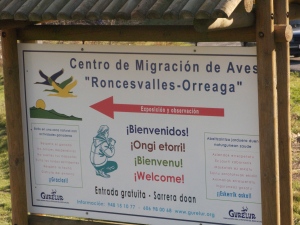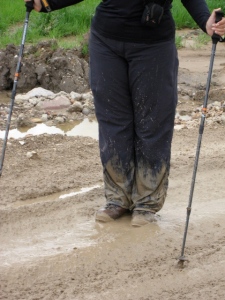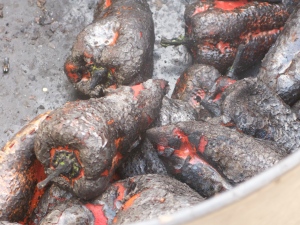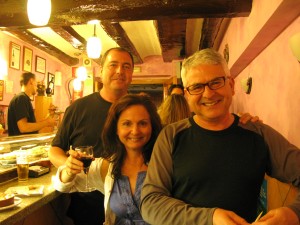The writer would like a dollar each time he is asked this question or variations of the following:
What is the best time of the year to do the Camino de Santiago?
This question is invariably and consistently asked in Camino Downunder classes and workshops in Australia and New Zealand. Ironically, when the question is posed, the participant has often made up his or her mind and wants validation that they have made the right choice. The writer would prefer that all future pilgrims keep an open mind, precisely because of the premise that you should make an informed choice; it’s a personal decision-making process; and most importantly you have to decide what are your priorities and not try to have everything, see everything and do everything whilst you’re undertaking the Camino de Santiago.
Nonetheless, all the options need to be put on the table – freedom of choice. Outlining to future pilgrims all the options is a de rigueur process in the classes. This process is much appreciated, whilst the participant weighs up the pros and cons.
WHAT ARE THE FOUR OPTIONS?
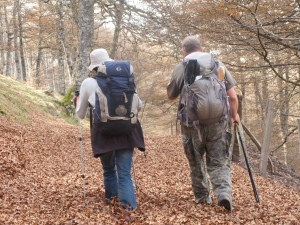
Late October, 2009 walking through the deciduous beech forest in the Pyrenees and just inside Spain
- SUMMER (verano) – June 21 to early September
- AUTUMN (otoño) – September 21 to early December
- WINTER (invierno) – December 21 to early March
- SPRING (primavera) – March 21 to early June
WHAT IS THE CURRENT SITUATION?
There is now a quasi formal pilgrimage “walking season”. Most pilgrim hostel accommodation usually closes for the winter months; all open their doors once Easter has finished (March or April) and these seasonal «albergues/refugios» (in Spanish) close their doors, sometime in November, and which varies from pilgrim hostel to pilgrim hostel. However, there are albergues and refugios which are open all year round for the very small winter pilgrimage foot traffic. More about the winter pilgrimage traffic later.
The majority of Australians and New Zealanders prefer to undertake their pilgrimage during Spring or Autumn, as do most non-European pilgrims.
WHAT THEN ARE THE ATTRACTIONS AND CHALLENGES FOR EACH SEASON?
Summer:
- Summer crops along the Meseta are maturing to full growth as are the vegetable gardens (huertas) in the first two regions (Navarra and La Rioja).
- In early September (late summer) wheat harvesting commences on the Meseta. Grape harvesting (mostly manual labour) is taking place in all the wine regions along the Camino Francés (Navarra, La Rioja and the Bierzo region of León province).
- Most, if not all the snow found on the GR65 (la Route Napoléon) between St-Jean-Pied-de-Port and Col de Lepoeder (just inside Spain) has disappeared and the track is now quite dry (unless it has been rain affected). There still may be seen some snow on the peaks of the Cantabrian Mountain ranges which are always on the right hand side (north) as the pilgrim travels west.
- Summer heat is at its strongest – certainly in the afternoon and should be avoided when it is most intense during the mid-afternoon (around 3.00 pm).
- If you are a morning person and you don’t mind getting up well before sunrise, you should begin walking during the cool of the morning (around 5.00 am), with its endearing qualities and finish soon after midday, to avoid the damaging afternoon sun on the Meseta between Burgos and Astorga – just over 200 hundred kilometres long.
- The challenge for the non-Spanish pilgrim is to adhere to the tried and tested Spanish siesta traditions (moving successfully between cultures): making sure you finish your walking before 1.00 pm and hopefully get to your designated albergue, going inside and staying there until around 5.00 pm when the central town squares (Las Plazas) burst into life with the locals doing their customary “paseo” – social stroll, to be seen and to meet; coinciding with commercial establishments and shops opening from the late afternoon to until 8.00 pm or later. What do you do for lunch? Hopefully, you would have obtained your provisions before 1.00 pm or eaten in a café bar located right on the Camino track which sometimes stays open during the daily siesta period and during the walking season.
- July and August are the peak times for the locals (Spaniards) who get on the track (mostly in Galicia to do a minimum 100 km of walking) during the peak summer holiday period.
- Some overcrowding may be experienced in the last region (Galicia).
- The foreign pilgrim experiences Spain up close and personal because life can now be better enjoyed outdoors from late afternoon, even in Northern Spain; the walking pilgrim is challenged each day to start very, very early.
- For ornithologists and bird lovers entering Spain and less than 2 kilometres from Roncesvalles, the Centro de Migración de Aves – Roncesvalles/Orreaga opens its doors on the Camino track from July 1 until end of November. Its purpose is to study and observe the 22 birds of prey and the 22 other migratory birds crossing overhead.
Autumn:
- The exquisite beauty of crossing the Pyrenees from France into Navarra Spain and walking through a variety of beech, oak, fir and wild pine deciduous forests especially in late October cannot be overestimated as well as the varied colours of the leaves which are either still clinging precariously on the trees or fallen to the ground.
- In the Pyrenees, the peak season (late September and October) for migratory birds and the huge size ‘scary and noisy’ birds of prey are all observed flying above the Camino de Santiago route and just a few kilometres before getting to Roncesvalles is the impressive bird interpretation and exhibition centre in three languages called: Centro de Migración de Aves.
- An “Indian Summer” is often experienced in late autumn – an extension of summer, characterised by sustained dry, warm weather.
- The pilgrim walking into Puente la Reina from Pamplona in late October early November will see on the Camino route the famous Spanish red peppers (pimientos de piquillo) being magically transformed by outdoor ovens: the outer skins are charred and blistered by the intense heat in order to release the exquisite sweet flavours inside the flesh. Many residential buildings along the Camino de Santiago in Navarra and La Rioja have pimientos de piquillo hanging around their balconies to dry.
- At the beginning of autumn in Logroño (capital of La Rioja): September 20 to September 26 are the Fiestas de la Vendimia Riojana – wine harvesting festivities lasting one full week and with the city figuratively exploding with people, processions, outdoor activities (viticulture) and with more gastronomy than usual.
- The Meseta is no longer green or yellow with grains and crops – the harvest is now complete: the soil is a dark brown colour; it lies fallow and unsown.
- The hunting season begins in both France and Spain – “la caza mayor (game hunting) and “la caza menor (shooting game birds only).
- Throughout Spain, but especially along the Camino Francés the culturally and gastronomically significant “Matanza del cerdo” (slaughter of the pig) takes place (mainly on 11 November – San Martín) and early December.
Winter:
- Its grand appeal and attraction in two words : character building.
- Between Christmas and end of January: the number of pilgrims on the track go down to single digit numbers per week (certainly in the Pyrenees and in Navarra)
- You must only do the Camino Francés in winter after you’ve done it a number of other times in other seasons: you should by then be reasonably familiar with terrain and topography.
- You must have reasonably good language skills in Spanish and French.
- The lambing seasons falls in winter and the early part of the year in Navarra – Pyrenees, La Rioja and Castilla y León.
- You must enjoy being on your own for most of the day and on most days and not be constrained with a rigid walking timetable. Time flexibility is important.
- You must “enjoy” walking through snow and ice; the physical challenges of being exposed to some extreme cold days and to sleeping in some non-centrally heated rooms.
- You must have either a duck or goose down jacket to wear for immediate and sufficient warmth once you stop walking. Remember that down jackets can never be used when you are walking: they do not wick out the huge amounts of moisture produced by the body when undertaking heavy-duty walking even if the ambient temperatures are minus zero.
- Your pilgrimage will be memorable and uplifting due to the many and varied encounters you will have with the locals, especially if you are on the Camino track during Christmas and the New Year period
Spring:
- European Summer Time (Spain and France have the same time because they are in Central Europe Time zone) begins in Spring: the last Sunday in March until the last Sunday in October – waking up in the dark, but being able to walk in daylight well past 9.00 pm.
- A veritable explosion of new growth and fauna are sprouting and birdsong is ever-present – flowers abound along the whole of the Camino.
- Weather volatility is at its extreme (April and May): such as in the Pyrenees on the Spanish side all-weather records were broken in the first two weeks of May, 2010 – the coldest recorded temperatures since records began in the middle of the 19th century. In the middle of May, 2010 it snowed in Burgos (800 metres above sea-level) which is on the Meseta. There is still significant snow on the Camino track above the treeline between France and Spain in the Pyrenees.
- In Navarra and La Rioja and on the Meseta: there can be continuous days of rain: even if rain ceases for many days, the pilgrim continues to negotiate walking in mud. It is the writer’s strong recommendation that walking with hi-tech gortex gaiters allows for a much better daily walking outcome. The unwritten and genuine joys of walking straight through mud holes without deviating when walking in gaiters is something to experience! See the earlier CaminoDownunder blog dated August 28, 2011: Good walking gear gives you a better walking outcome – PART ONE.
- The colour of the Meseta is green and vibrant with the growing wheat fields and dominating the landscape as far as the eye can see, accompanied by constant birdsong all around and every day.
CONCLUSION
When to walk the Camino de Santiago should be based on being well-informed, whilst understanding that each season’s attractions (colours, textures, appearances) is precisely determined by the yearly seasonal cycles which are unique for that season. Can one still listen to and enjoy Vivaldi’s Four Seasons violin concertos separately (la primavera; l’estate; l’autunno; l’inverno – in Italian)? Yes. However, to eventually listen to all the four concertos is to appreciate the differences and complexities of each. You can say one is your favourite or preferred; but you can’t say one is better or worse if you haven’t experienced it.
The choice made is on the understanding that you cannot experience all and have all the best in just one season – that’s being unrealistic. In other words, walking along the Camino de Santiago at any time of the year will offer you the very best, but only for that season along with its challenges.
Maybe, starting to walk in one season and finishing up in other season allows the future pilgrim the opportunity to experience two seasons for the price of one pilgrimage in one walking season only. Think about that as being a viable alternative.
